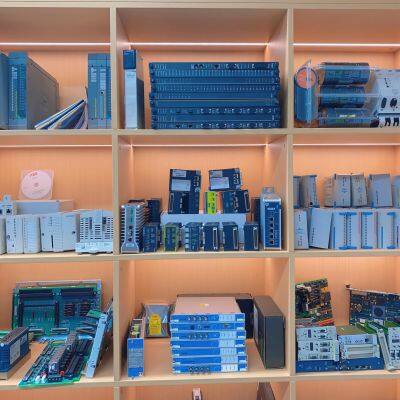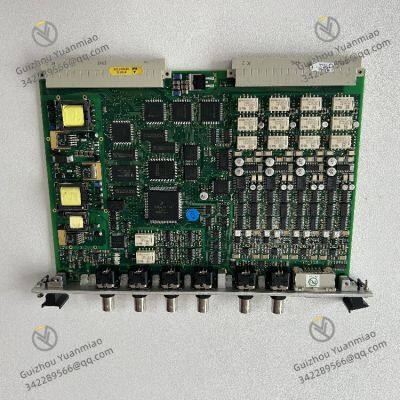Product Description
VIBRO-METER MPC4 200-510-078-115, as a core component - mechanical protection card in the VM600 series mechanical protection system, is a "guardian" for monitoring the operating status and preventing faults of industrial equipment. With powerful signal processing capability, flexible function configuration and high-reliability design, this protection card can accurately monitor key parameters such as equipment vibration and rotational speed in real time, timely capture potential equipment faults, provide a solid guarantee for the stable operation of large rotating equipment such as steam turbines, compressors and motors, and play an indispensable role in industrial fields such as electric power, petrochemical industry and manufacturing.

I. Core Functions
(1) Multi-type Signal Acquisition and Processing
Comprehensive compatibility with dynamic signals: MPC4 200-510-078-115 is equipped with 4 dynamic signal input channels, which can collect and analyze various types of dynamic signals. These channels support the access of signals such as acceleration, velocity and displacement (e.g., shaft displacement measured by eddy current sensors), meeting the diverse needs for monitoring equipment operating status in different industrial scenarios. In steam turbine monitoring, acceleration signals can be used to monitor the vibration impact of the unit, and displacement signals can be used to grasp the operating position of the shafting in real time, so as to comprehensively evaluate the operating health status of the equipment.
Accurate measurement of rotational speed signals: It is configured with 2 rotational speed (tachometer) input channels, which can receive signals from various rotational speed sensors, including those based on eddy current probes, magnetic pulse sensors or TTL signal output. Moreover, the card supports fractional speed ratio measurement, which can adapt to complex equipment transmission systems. For example, in multi-stage compressors, it can accurately measure the rotational speed of shafts with different speeds, providing accurate data for equipment speed control and operating efficiency evaluation.
In-depth digital signal processing: It has built-in advanced digital processing algorithms, including digital filtering, integration/differentiation (as needed), rectification (RMS, average, true peak or true peak-to-peak), order tracking (amplitude and phase), and sensor-target gap measurement. Digital filtering can effectively remove noise interference in the signal, and order tracking can accurately analyze the vibration characteristics of specific orders when the equipment is running at variable speeds, helping engineers accurately locate the root cause of equipment faults.
(2) Flexible Parameter Configuration and Alarm Settings
Free setting of units and ranges: Calibration parameters can be displayed in metric or imperial units, facilitating users with different regional and industry standards. At the same time, the measurement range of each channel can be flexibly adjusted according to actual monitoring needs. For example, the vibration measurement range can be set within 0-100μm (displacement), 0-100mm/s (velocity), etc., to ensure the accuracy and effectiveness of measurement data.
Fine programming of alarm thresholds: For each measurement channel, alarm thresholds can be independently set, including two levels: Alert and Danger. Alarm time delay, hysteresis and latching function can also be freely set through programming. Taking motor monitoring as an example, it can be set that when the vibration amplitude exceeds the alert threshold of 50μm, an alert signal is sent with a delay of 2s; if it continues to rise and exceeds the danger threshold of 80μm, a danger alarm is immediately triggered and latched, so as to avoid false alarms caused by transient interference and ensure that real fault hidden dangers can be detected in time.
Condition-related alarm: Alarm thresholds can also be associated with equipment speed or other external information. During the operation of a fan, it can be set that as the speed increases, the vibration alarm threshold is dynamically adjusted accordingly, making the alarm settings more in line with the actual operating conditions of the equipment and improving the scientificity and reliability of fault early warning.
(3) System Collaboration and Data Output
High-speed backplane communication: Through the VM600 system backplane bus, MPC4 can achieve high-speed communication with other modules in the system (such as central processing unit module CPUM, input/output module XIO, etc.), with a data transmission rate of up to 100Mbps. It uploads the processed equipment operation data to the central controller in real time, and receives control commands and configuration parameter updates from the central controller, ensuring the efficiency of system collaborative work.
Analog output: At the rear of the rack (corresponding to the front panel of the IOC4T card), processed dynamic (vibration) signals and rotational speed signals can be output as analog signals, providing two standard output forms based on voltage (0-10V) and current (4-20mA), facilitating data interaction with other external equipment (such as recorders, control systems) and realizing more extensive system integration applications.
Digital alarm output: For each alarm level, there is a digital output interface on the corresponding IOC4T card. These alarm signals can be transmitted through the bus in the VM600 rack to drive the relays on optional relay cards (such as IRC4 and RLC16) to act, realizing control interlocking of external equipment, such as automatically cutting off the power supply or starting standby equipment when the equipment fails, so as to ensure the safety of the production process.

II. Hardware Characteristics
(1) Rugged Industrial Design
Wide temperature operation guarantee: The operating temperature range is -20℃ to +60℃, which can adapt to various harsh industrial environments. Whether it is outdoor equipment in cold areas or mechanical equipment in high-temperature workshops, it can operate stably and reliably, ensuring that equipment monitoring work is not affected by ambient temperature.
Strong anti-interference capability: It has passed strict electromagnetic compatibility tests, such as complying with EN 61000-6-2 standard, and can work normally near strong electromagnetic interference sources such as frequency converters and motors, effectively resisting the impact of electromagnetic interference on signal acquisition and processing, and ensuring the accuracy and stability of monitoring data.
High-quality hardware selection: It is encapsulated with a metal shell, with a protection level of IP20, which can effectively prevent dust; internal components are all industrial-grade products, with a mean time between failures (MTBF) of ≥100,000 hours, ensuring long-term stable operation from the hardware level, and reducing equipment maintenance costs and failure risks.
(2) Convenient Installation and Maintenance Design
Standard rack mounting: The size is adapted to the 19-inch standard rack of the VM600 system (height 3U), and adopts a plug-in rail mounting method. The installation and replacement process does not require disassembly of other modules, and can be completed by a single person within 5 minutes, which greatly facilitates system expansion, maintenance and upgrade work.
Intuitive status indication: The front panel is equipped with LED indicators for intuitively displaying the working status of the module. Among them, one LED indicator is used to indicate whether a processing error or hardware failure has occurred; in addition, each input channel corresponds to one LED, which can respectively display whether the channel is detected to be faulty by the "ok system" and whether an alarm is triggered, so that maintenance personnel can quickly locate the fault point and improve maintenance efficiency.
Reliable wiring design: The wiring terminals adopt a rugged and durable design, with reliable connection and easy operation. The terminal block is clearly marked with channel numbers and functions, reducing the risk of wiring errors; at the same time, it can support the connection of wires of different specifications to meet diverse on-site wiring needs.

III. Application Scenarios
(1) Electric Power and Energy Industry
Steam turbine generator set monitoring: In thermal power plants, MPC4 200-510-078-115 is used to monitor parameters such as vibration and rotational speed of steam turbine generator sets in real time. Through accurate measurement of steam turbine shafting vibration, potential faults such as shafting imbalance, misalignment and bearing wear can be found in time; at the same time, the rotational speed of the generator rotor is monitored to ensure stable power generation frequency and guarantee the safe and stable supply of electric power production.
Fan status monitoring: In wind farms, the vibration of wind turbine blades and the rotational speed of the hub of wind turbines are monitored. Vibration signals are used to analyze whether the blades have faults such as cracks and deformation, and rotational speed monitoring is used to judge whether the fan is in the best operating state. The pitch angle and yaw angle of the fan are adjusted in time to improve power generation efficiency and extend the service life of the fan.
(2) Petrochemical Industry
Compressor protection: In the petrochemical production process, reciprocating compressors and centrifugal compressors are core equipment. MPC4 can monitor the vibration of the compressor in real time, such as abnormal vibration caused by wear of pistons and cylinders, sudden vibration changes caused by impeller imbalance, etc. By setting reasonable alarm thresholds, equipment faults can be found in time and measures can be taken to avoid production interruption due to compressor faults and ensure the continuity of chemical production processes.
Pump equipment monitoring: Vibration and rotational speed of various transfer pumps (such as crude oil transfer pumps, chemical raw material pumps) are monitored. By monitoring the vibration of the pump, it can be judged whether the pump body has problems such as cavitation and bearing damage; combined with rotational speed monitoring, the flow rate of the pump is ensured to be stable, meeting the requirements of the production process for fluid transfer, and preventing safety accidents such as material leakage caused by pump faults.
(3) Manufacturing Industry
Machine tool equipment maintenance: In the processing process of CNC machine tools, MPC4 can monitor the vibration and rotational speed of the machine tool spindle. By analyzing vibration signals, problems such as spindle bearing wear and tool wear can be found in time, avoiding the impact of equipment faults on processing accuracy and product quality; at the same time, cutting parameters are adjusted according to rotational speed monitoring to improve processing efficiency and realize intelligent maintenance management of machine tool equipment.
Large motor monitoring: In large motor drive systems in factories, the vibration and rotational speed of the motor are monitored in real time to prevent abnormal vibration and rotational speed fluctuations caused by rotor imbalance, stator winding faults, etc., ensuring the stable operation of the motor, avoiding production line shutdown due to motor faults, and reducing production losses.


GE IS410SRLYS2A Simplex Terminal Board
GE IS400STCIS2AFF Terminal Board
GE IS400STAIS2AED Simplex Terminal Board
GE IS400SRLYS2ABB Simplex Terminal Board
GE IS200JPDMG1ACC Power Distribution Card
GE IS420UCSCH1A-F-V0.1-A Controller
GE UCSC H1 IS420UCSCH1A-B Controller
GE PRG-MODEM Regulator module
GE WES5162 Frame rack
Allen-Bradley 1756-2WS Weigh Scale Module
RELIANCE ELECTRIC S-D4012 PLC controller
LAM 810-800082-043 VME BREAKOUT BOARD
Allen-Bradley 1756-A7 Seven (7) slot Chassis
Allen-Bradley 1756-A13 Seven (13) slot Chassis
Allen-Bradley 1756-CN2R ControlNet Communication Module
Allen-Bradley 1756-CN2RXT Controlnet Redundant Interface Module
Allen-Bradley 1756-CNB ControlNet Interface Module
Allen-Bradley 1756-DHRIO ControlLogix DH Plus/RIO Comms Module
 yezi
Hi there! Welcome to my shop. Let me know if you have any questions.
yezi
Hi there! Welcome to my shop. Let me know if you have any questions.





